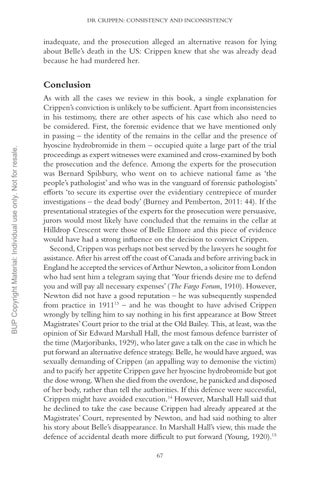DR CRIPPEN: CONSISTENCY AND INCONSISTENCY
inadequate, and the prosecution alleged an alternative reason for lying about Belle’s death in the US: Crippen knew that she was already dead because he had murdered her.
BUP Copyright Material: Individual use only. Not for resale.
Conclusion As with all the cases we review in this book, a single explanation for Crippen’s conviction is unlikely to be sufficient. Apart from inconsistencies in his testimony, there are other aspects of his case which also need to be considered. First, the forensic evidence that we have mentioned only in passing – the identity of the remains in the cellar and the presence of hyoscine hydrobromide in them – occupied quite a large part of the trial proceedings as expert witnesses were examined and cross-examined by both the prosecution and the defence. Among the experts for the prosecution was Bernard Spilsbury, who went on to achieve national fame as ‘the people’s pathologist’ and who was in the vanguard of forensic pathologists’ efforts ‘to secure its expertise over the evidentiary centrepiece of murder investigations – the dead body’ (Burney and Pemberton, 2011: 44). If the presentational strategies of the experts for the prosecution were persuasive, jurors would most likely have concluded that the remains in the cellar at Hilldrop Crescent were those of Belle Elmore and this piece of evidence would have had a strong influence on the decision to convict Crippen. Second, Crippen was perhaps not best served by the lawyers he sought for assistance. After his arrest off the coast of Canada and before arriving back in England he accepted the services of Arthur Newton, a solicitor from London who had sent him a telegram saying that ‘Your friends desire me to defend you and will pay all necessary expenses’ (The Fargo Forum, 1910). However, Newton did not have a good reputation – he was subsequently suspended from practice in 191113 – and he was thought to have advised Crippen wrongly by telling him to say nothing in his first appearance at Bow Street Magistrates’ Court prior to the trial at the Old Bailey. This, at least, was the opinion of Sir Edward Marshall Hall, the most famous defence barrister of the time (Marjoribanks, 1929), who later gave a talk on the case in which he put forward an alternative defence strategy. Belle, he would have argued, was sexually demanding of Crippen (an appalling way to demonise the victim) and to pacify her appetite Crippen gave her hyoscine hydrobromide but got the dose wrong. When she died from the overdose, he panicked and disposed of her body, rather than tell the authorities. If this defence were successful, Crippen might have avoided execution.14 However, Marshall Hall said that he declined to take the case because Crippen had already appeared at the Magistrates’ Court, represented by Newton, and had said nothing to alter his story about Belle’s disappearance. In Marshall Hall’s view, this made the defence of accidental death more difficult to put forward (Young, 1920).15 67

